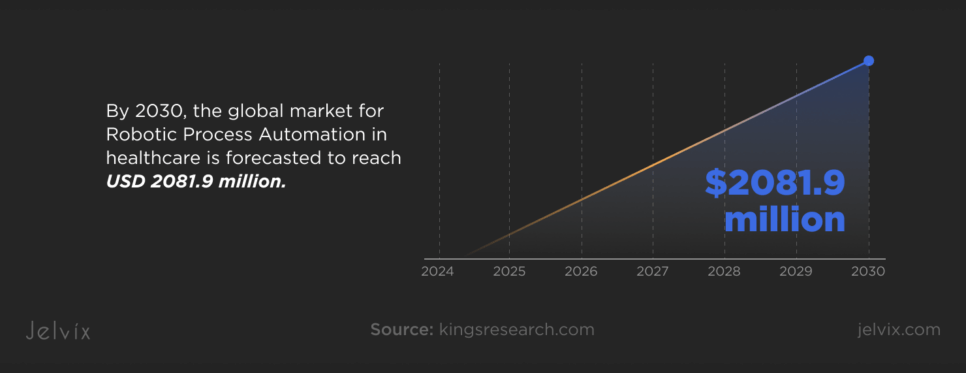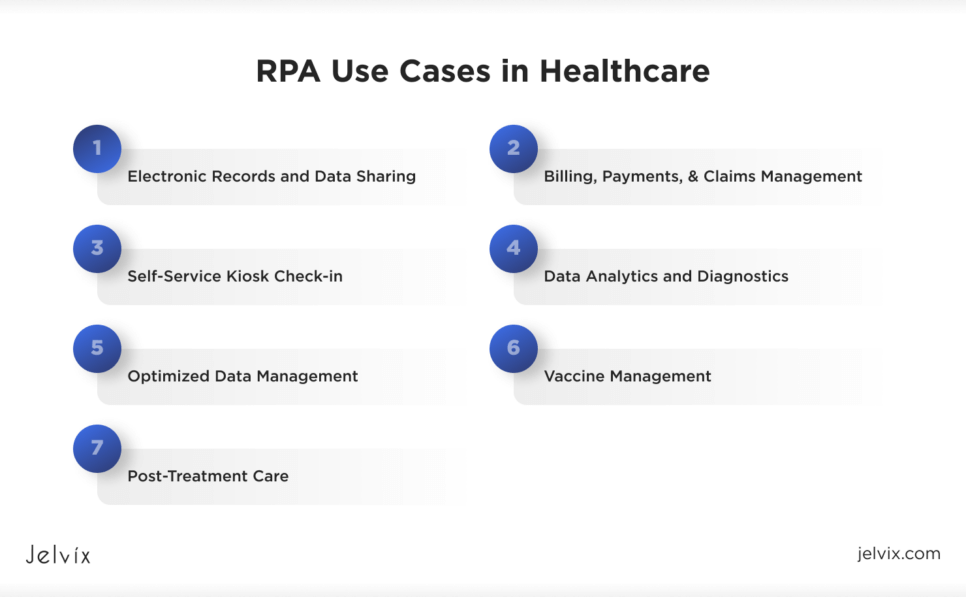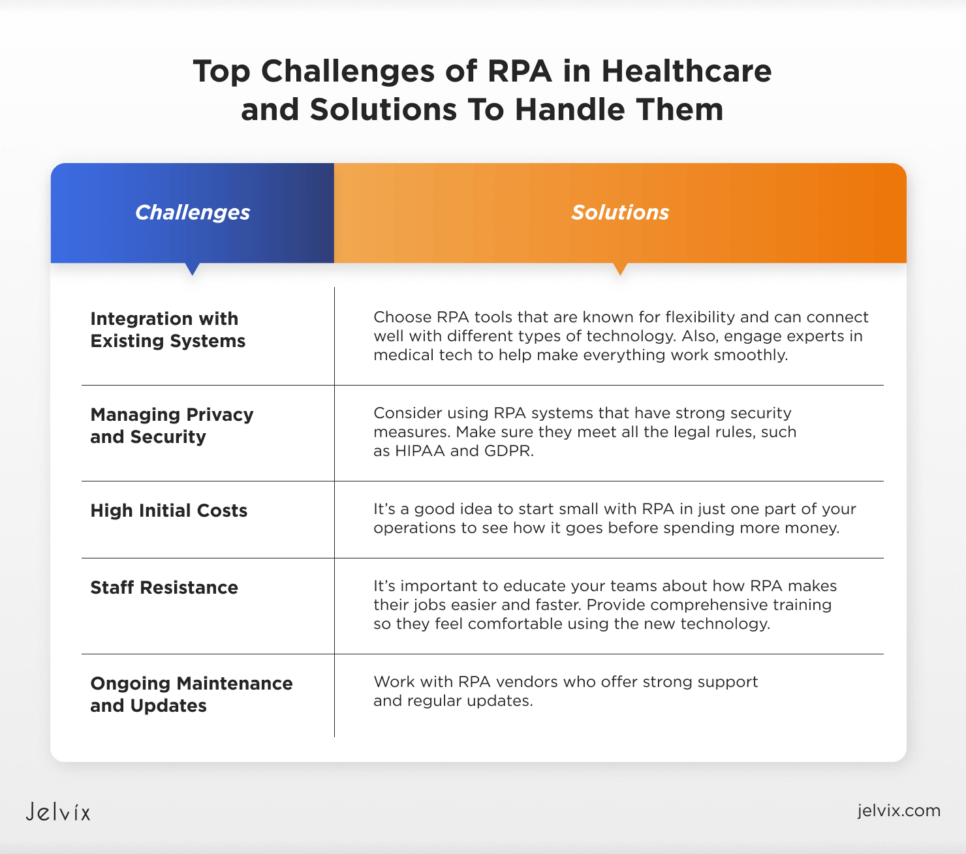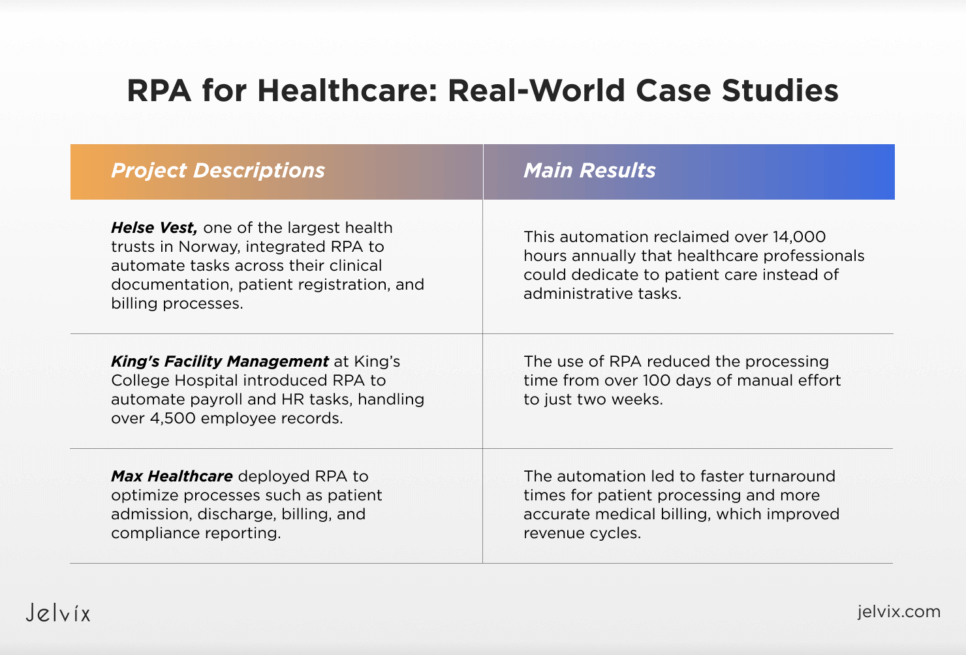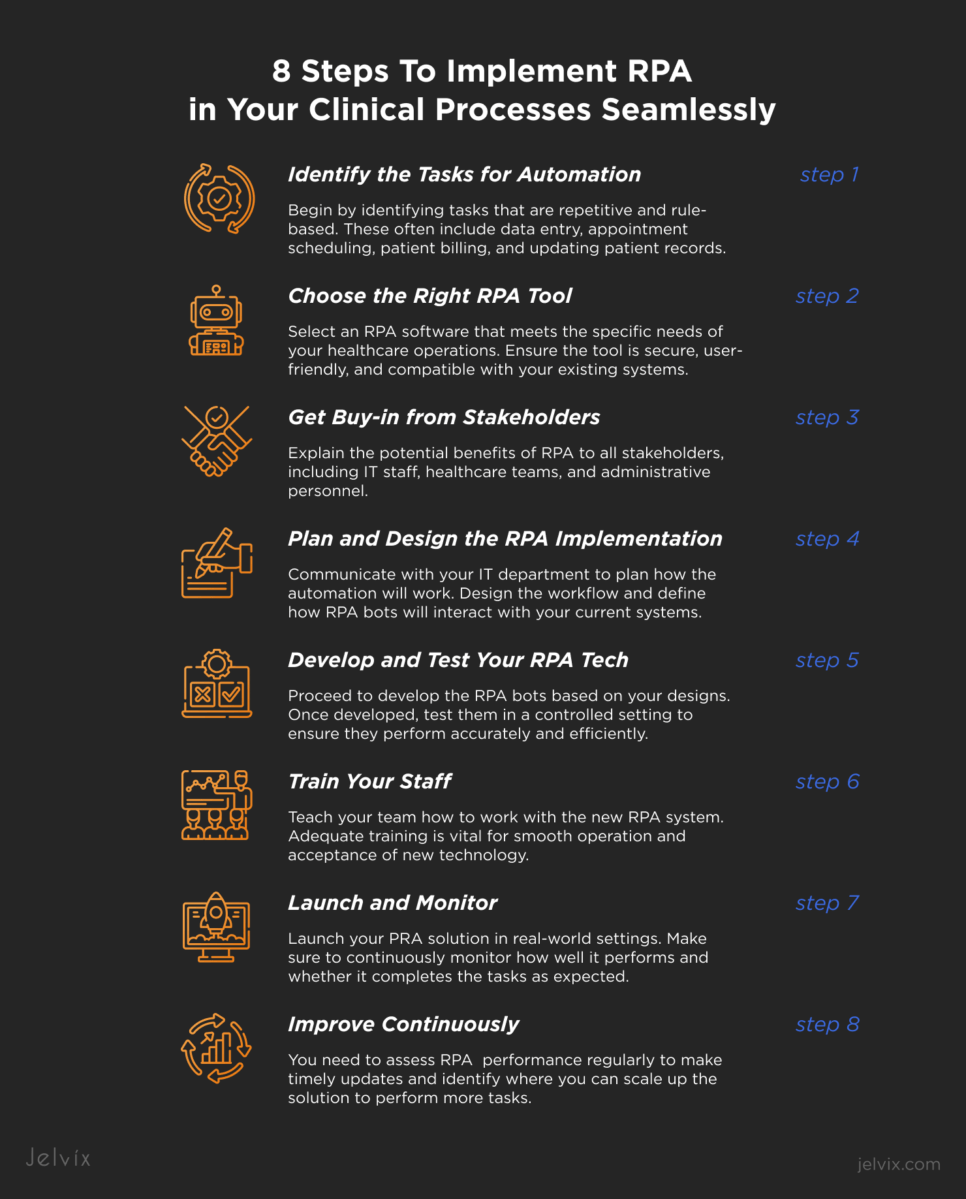The healthcare industry is facing significant challenges in managing the overwhelming amount of patient data and the errors that come with it. Studies show that human error lies behind almost 80% of major incidents in healthcare settings.
The problem is that clinics often lack resources to identify and correct errors in medical data. They often suffer from incorrect resource allocation resulting in low clinical efficiency and high operational costs. So, many of them opt for robotic process automation to get the job done error-free.
If you face workflow inefficiencies because of errors in healthcare data and aim to prevent them with RPA, read this article. You’ll find out how to implement robotic automation correctly to fix your clinical processes and increase your company’s return on investment.
What Is RPA in Healthcare?
Robotic process automation in healthcare uses software robots to handle tasks that are usually done by people. These tasks, such as setting up appointments, handling insurance claims, keeping track of patient records, and managing billing, can be simple but take a lot of time and effort.
RPA tools act like humans by interacting with computers to do these jobs quicker and with fewer mistakes. This helps make the healthcare system run smoother and lets doctors spend more time with patients instead of filling out forms.
The State of RPA in Healthcare: Market Statistics To Consider
The healthcare automation market is on the rise. It is expected to reach USD 2,081.9 million by 2030, with North America dominating the global market. The need for better operational efficiency and cost savings are the primary drivers of this rapid growth.
Studies show that 90% of medical enterprises around the world have an automation strategy, while 34% have already implemented automation solutions. Speaking about robotic automation, 78% of companies who have already integrated RPA consider increasing their investments even though scaling RPA solutions isn’t easy.
Research organizations and medical companies see RPA as a highly beneficial solution for financial operations at healthcare entities. In particular, robotic automation can reduce the time and costs spent on transactional processes by 60 to 80% on average.
Key Benefits of RPA in Healthcare
RPA is making a big deal in healthcare, helping clinics do their work better, keep patients safe, and reduce operational costs. These benefits highlight how PRA can be useful for your medical company and what you can achieve after implementing this technology.
Better Efficiency
Data entry, appointment scheduling, and patient registration are time-consuming tasks that PRA can easily automate. As a result, you can expect faster clinical processes and a reduction of administrative workload for staff, allowing them to focus on more critical processes.
Improved Accuracy
Handling medical data manually often results in errors that, in some cases, can be critical and costly. PRA can reduce the likelihood of mistakes by processing data accurately, keeping patient records safe, and doing billing tasks following industry regulations.
Cost Reduction
When tasks are automated, your clinic is likely to experience a reduced need for manual labor. It means you can cut down on operational costs and minimize the likelihood of errors that could lead to financial losses due to claims, rejections, or legal fines.
Enhanced Patient Care
With administrative tasks automated, healthcare professionals have more time to focus on patient care. This can lead to better patient outcomes and higher satisfaction rates as the staff can provide more personalized attention.
Scalability
RPA technology can scale up or down based on your healthcare needs. As your clinic grows, RPA systems can handle increased loads without the need for additional staffing.
Compliance and Security
RPA helps in maintaining compliance with healthcare regulations. It can be programmed to follow exact regulatory processes, ensuring that all operations are compliant with laws like HIPAA. What’s more, RPA reduces human access to sensitive data, which enhances privacy and security.
Improved Data Management
RPA facilitates data management by collecting and organizing data from various sources. This consolidated data can then be used for analytics, helping healthcare teams make informed decisions based on accurate data insights.
RPA Use Cases in Healthcare: How Robotic Automation Improves Clinical Processes
RPA has the potential to improve various aspects of healthcare like data sharing, payment processes, vaccine management, and patient diagnostics. If your medical teams are overwhelmed with data and lose productivity, it might be the right time to automate your clinical process.
Electronic Records and Data Sharing
Automating the entry of patient data into electronic health records is a good robotic process automation example. Such automation helps ensure that medical data is accurately shared across different healthcare systems. This reduces manual errors, speeds up data access for healthcare teams, and leads to better-coordinated care.
Billing, Payments, and Claims Management
RPA can automate the processing of claims and manage billing by extracting data from forms, entering it into billing systems, and verifying insurance coverage automatically. As a result, clinics get faster claims processing, reduced errors, and improved cash flow management.
Self-Service Kiosk Check-In
RPA can manage data entry for self-service kiosks, allowing patients to check in, update their information, and schedule appointments without staff assistance. This reduces wait times and administrative workload while improving the patient experience and satisfaction at check-in.
Data Analytics and Diagnostics
RPA gathers and preprocesses large datasets for analysis, helping physicians gain insights into patient outcomes and treatment effectiveness. This enhanced decision-making based on comprehensive data analytics can lead to better patient outcomes and more personalized care.
Optimized Data Management
RPA can automate routine data tasks, such as data entry, migration, and updates across healthcare systems. As a result, your clinic gets more efficient data handling, reduced risk of data errors, and free time for healthcare professionals to focus on patient care.
Vaccine Management
RPA can streamline the management of vaccine inventories, track vaccination records, and schedule appointments. This ensures improved vaccine rollout efficiency, accurate tracking of vaccination rates, and better public health outcomes.
Post-Treatment Care
With the help of RPA, clinics can automate follow-up appointment scheduling, patient monitoring, and sending reminders for medication or check-ups. This results in consistent post-treatment care, enhanced patient compliance with treatment plans, and reduced readmission rates.
By automating these key medical areas, RPA helps boost operational efficiency and enhance the quality and speed of overall quality across your clinic.
Top Challenges of RPA in Healthcare and Solutions To Handle Them
Using robotic automation in healthcare can be truly beneficial, but it also comes with a set of challenges that you need to address carefully. By understanding these challenges and preparing solutions in advance, you can make the most out of your RPA tech, improving your services and making things better for patients and staff.
Integration with Existing Systems
Sometimes, RPA software has a hard time working with existing medical systems. Choose RPA tools that are known for flexibility and can connect well with different types of technology. Also, engage experts in medical tech to help make everything work smoothly.
Managing Privacy and Security
Protecting patient information is of utmost importance in healthcare, and using robots to handle data could make it risky. Consider using RPA systems that have strong security measures. Make sure they meet all the legal rules, such as HIPAA and GDPR, to keep patient data safe and prevent costly breaches.
High Initial Costs
Starting with RPA can be expensive because you need to buy the software, set it up, and train your teams to use it. The Jelvix team recommends that you plan your budget carefully. It’s a good idea to start small with RPA in just one part of your operations to see how it goes before spending more money.
Staff Resistance
Very often, employees don’t appreciate changes in the set clinical process, especially those including new tech. They might not like the new robotic tools or might be scared of losing their jobs to robots. It’s important to educate your teams about how RPA makes their jobs easier and faster. Provide comprehensive training so they feel comfortable using the new technology.
Ongoing Maintenance and Updates
Like any other software, RPA tools require updates and maintenance, which can take a lot of time and financial resources. Work with RPA vendors who offer strong support and regular updates. This way, you can keep the software running smoothly without too much hassle.
RPA for Healthcare: Real-World Case Studies
As you already know, companies around the globe implement RPA to make their processes more efficient and reduce costs. Looking through real-world success stories can help you evaluate what tasks you need to automate and what outcomes you can expect after implementing RPA solutions.
Saving Time for the Staff
Helse Vest, one of the largest health trusts in Norway, integrated RPA to automate tasks across their clinical documentation, patient registration, and billing processes. This automation reclaimed over 14,000 hours annually that healthcare professionals could dedicate to patient care instead of administrative tasks. The efficiency gained led to quicker patient processing times and reduced waiting periods, greatly improving patient satisfaction and quality of care.
Reducing Manual Work
King’s Facility Management at King’s College Hospital introduced RPA to automate payroll and HR tasks, handling over 4,500 employee records. The use of RPA reduced the processing time from over 100 days of manual effort to just two weeks. This reduction allowed them to cut down costs and enhance the accuracy of payroll operations, minimizing errors in employee compensation and benefits allocation.
Enhancing Clinical Efficiency
Max Healthcare deployed RPA to optimize processes such as patient admission, discharge, billing, and compliance reporting. As a result, they achieved significant improvements in operational efficiency and service quality. The automation led to faster turnaround times for patient processing and more accurate medical billing, which improved revenue cycles.
Navigate the complex process of choosing a health tech partner with Jelvix's comprehensive guide. Find essential criteria and expert insights for successful collaborations in healthcare.
8 Steps To Implement RPA in Your Clinical Processes Seamlessly
Implementing RPA in your healthcare company can seem daunting, but following a step-by-step approach can make the process smoother and more effective. By following the steps listed below, you can successfully implement RPA and expect better efficiency in your clinical operations.
1. Identify the Tasks for Automation
Begin by identifying tasks that are repetitive and rule-based. These often include data entry, appointment scheduling, patient billing, and updating patient records. To ensure you choose the right tasks for automation, consider using techniques like activity diagrams and value stream mapping. These tools help visualize the workflow and identify areas where RPA can have the most impact.
2.Choose the Right RPA Tool
Select an RPA software that meets the specific needs of your healthcare operations. Ensure the tool is secure, user-friendly, and compatible with your existing systems, such as EHRs and CRMs. Compatibility is what you need for smooth integration and operation.
3. Get Buy-In From Stakeholders
Explain the potential benefits of RPA to all stakeholders, including IT staff, healthcare teams, and administrative personnel. Support from these user groups is important for tackling resistance and setting up a cooperative atmosphere. Highlight the benefits, such as reduced workload and improved accuracy, to gain their support.
4. Plan and Design the RPA Implementation
Communicate with your IT department and the chosen RPA vendor to plan how the automation will work. This step involves designing the workflow and defining how RPA bots will interact with your current systems.
5. Develop and Test Your RPA Tech
Proceed to develop the RPA bots based on your designs. Once developed, test them in a controlled setting to ensure they perform accurately and efficiently. Testing helps identify issues before going live and reduces the risk of errors.
6. Train Your Staff
Teach your team how to work with the new RPA system. They should understand how to monitor and manage the bots and what to do in case of errors or unexpected issues. Adequate training is vital for smooth operation and acceptance of new technology.
7. Launch and Monitor
Launch your PRA solution in real-world settings. Make sure to continuously monitor how well it performs and whether it completes the tasks as expected. You need to do this because monitoring helps evaluate the impact of automation on your clinical process and make improvements where needed.
8. Improve Continuously
RPA is a complicated software that requires your attention all the time. You need to assess its performance regularly to make timely updates and identify where you can scale up the solution to perform more tasks. This way, you can make the most out of RPA in your healthcare operations.
Factors that Impact How Quickly an RPA Solution Can Pay Off
According to the Global RPA survey by Deloitte, a payback for PRA solutions can be expected in less than one year. In healthcare, it can vary depending on various factors, such as the scale of the deployment, the complexity of the automated processes, and the effectiveness of your implementation strategy.
Nature of Automated Tasks
If RPA is applied to high-volume and repetitive tasks, the payback can be quicker. Automating complex processes that involve multiple systems usually takes longer to get returns but can provide significant savings and efficiency gains later.
Implementation Efficiency
A well-planned and smoothly made implementation can lead to quicker ROI. This includes proper selection of processes for automation, quality of the RPA software, and adequacy of training provided to staff.
Extent of Cost Savings
RPA reduces the need for manual labor in administrative tasks. The direct cost savings from reduced labor expenses often manifest quickly and continue to accrue, contributing to a faster ROI.
Accuracy and Compliance Gains
By reducing human errors, RPA decreases the costs associated with corrections and non-compliance with regulations. This indirect saving can be significant over time, especially in reducing risks of fines and rework.
Productivity Enhancements
RPA allows healthcare staff to focus on patient care and other high-value tasks, potentially leading to better health outcomes and higher patient satisfaction. These benefits can lead to long-term returns, although they’re pretty hard to quantify.
Note that the actual timeframe can vary based on the specific circumstances and goals of your medical company. That’s why conducting a cost-benefit analysis to understand the potential ROI before implementing RPA can be a good idea for you.
How Jelvix Can Help Implement RPA into Your Medical Settings
As the volume of healthcare data grows, medical companies will eventually face the need to automate at least some of their processes to preserve clinical efficiency and save costs. Yet, implementing solutions like RPA is a complex process that requires deep tech expertise.
At Jelvix, we help medical enterprises develop and implement RPA, AI, and machine learning solutions to automate their daily operations. If you need help evaluating where automation will give you the best outcomes, reach out to our experts. They will help you assess your company’s current state and offer the best solution based on your operational needs and business goals.
Need a qualified team of developers?
Scale your development capacity with top-level expertise and resources.


